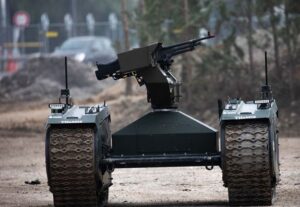Military operations are way more difficult than it looks because it includes the risk of human lives. The nature of war has significantly transformed since the end of world war II.
“Battle lines are presently opaque due to the increasing use of technology”- Feras A. Batarseh.
To account for the growing lethality of war, a heavy budget is necessary to manage ample duties. Undoubtedly, the deployment of computational agents and artificial intelligence can reduce the large budget and risks of human lives on the battlefield. Robots dealing with novelty is a viable solution in this case. Indeed, the employment of robotics on the battlefield is nothing new as many of the robots have been implemented that were either unproductive or used only for limited operations.

Despite its various benefits such as accomplishing the mission, immunity to chemicals, and faster target engagement, those robots were susceptible to technical breakdowns. An error in targeting and use of weapons can cause disastrous situations for civilians. Reportedly, robots are likely to commit atrocities and break the basic rules of the field. In this case, the robots are not seen as more beneficial but they contradict. Cyber security and attacks are too common in the sects where robots or AI are being used. However, robots can bring a great change on the battlefield because of their better observations and sensory features. The recent development of a remote-controlled armed robot named REX MKII by Israel aerospace industries has shown unique features such as patrolling battle zones, tracking infiltrators, and open fire.

This integration of dynamic features is encouraging the units to adopt robotics in warfare. No doubt it can have long-term benefits for warfare but it needs more improvements. Again, the technological revolution propelled by AI and robotics is the urgency of the hour to improve efficiency, productivity, and optimization across firms and industries. Hence, the deployment of robots on the battlefield is still dealing with ethical dilemmas and it is suggested that thorough research is needed prior to maximize the opportunities while reducing the humanitarian loss simultaneously. Rapid improvements in robotics and AI are showing the possibilities of killer robots in the field.
References
Johnson, J. (2020). Artificial intelligence, drone swarming, and escalation risks in future warfare. The RUSI Journal, 165(2), 26-36. Retrieved from https://www.researchgate.net/profile/James-Johnson-117/publication/340703560_Artificial_Intelligence_Drone_Swarming_and_Escalation_Risks_in_Future_Warfare/links/60b60ee64585154e5ef64b18/Artificial-Intelligence-Drone-Swarming-and-Escalation-Risks-in-Future
Swett, B. A., & Llorens, A. J. (2021). Designing Robots for the Battlefield: State of the Art. Retrieved from https://library.oapen.org/bitstream/handle/20.500.12657/47279/9783030541736.pdf?sequence=1#page=131
Feras A. Batarseh & Abhinav Kumar (2020). The use of robots and artificial intelligence in war. LSE. Retrieved from https://blogs.lse.ac.uk/businessreview/2020/02/17/the-use-of-robots-and-artificial-intelligence-in-war/